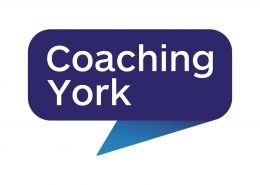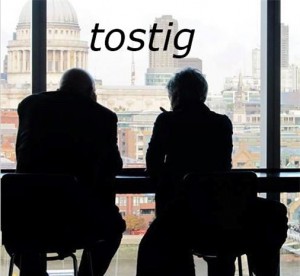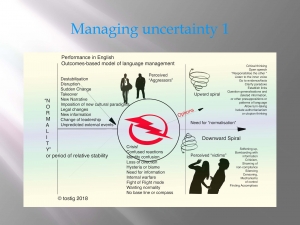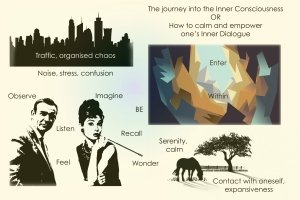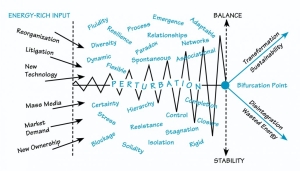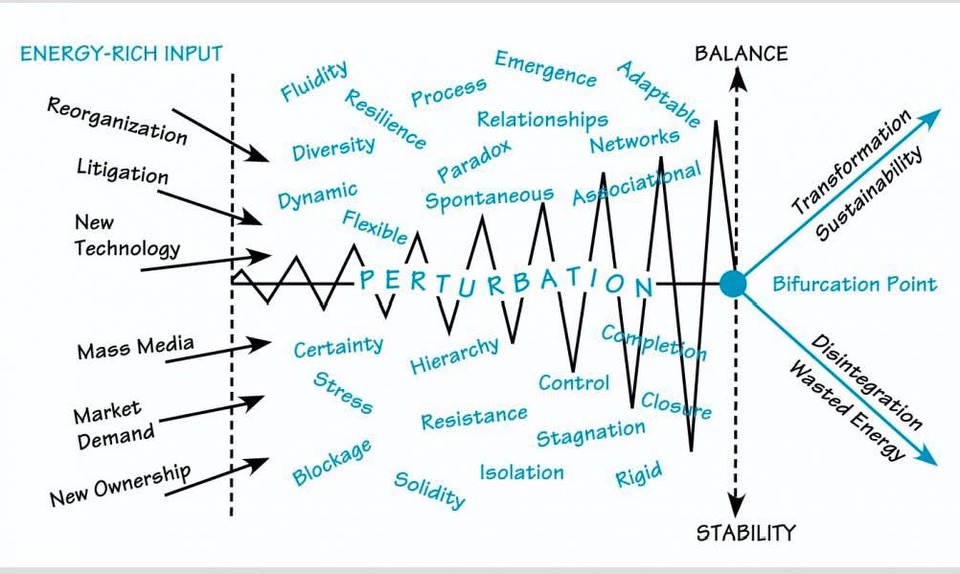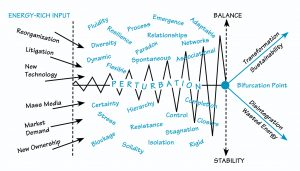Performance in English works in York, England, and internationally,
With the C-19 lockdown, our courses are being provided
on Skype, Teams, Webex and Zoom
• Qualified trainers and coaches with more than 30 years’ experience of training and business management:
• Having impactful communication skills is essential to successful outcomes in business – does your team have a level of performance required to lead international projects in English?• All our workshops are tailor-made to each client’s needs with the aim of maximising effectiveness in the complex international workplace.
• Our programmes are hands-on and in English to focus on key aspects of participants’ performance in real contexts.
|
|||||||||||
|
||||||||||
|
||||||||||
|
||||||||||
|
||||||||||
|
||||||||||
|
||||||||||
|
||||||||||
|
||||||||||
|
||||||||||
|
|||||||||||||
|
|||||||||||||||||||||||||
|
|||||||||||
This workshop will develop practice around the coach in a facilitator role when helping manage communication and self-awareness problems caused by a destabilising scenario.
I will build on the more theoretical aspects of last year’s session (which explained cross-overs between language teaching, learning and acquisition, with outcomes-based, target-oriented and process-based methods adopted by coaches or trainers) and, using the subject’s own personal experience of destabilising situations, develop an embodied practice, using an entirely flexible approach that allows for feedback and both objective and subjective improvements. This will be mainly a stand-up workshop, where the nature of destabilisation – within organisations and the bodily experience – based on personal experiences and systems and organisational theory, will be examined. The workshop is tabled to last 2 hours but could go on longer. A manageable number for this is around 12 persons max.
The coach develops skills that help the subject to grow in embodied self-awareness and social awareness, embodied self-management and social management while at the same time exploring his/her own levels of linguistic awareness. This process allows for the emergence of new language to better manage destabilised scenarios, that each person is comfortable with, and to observe how this works, making for more congruent behaviours and the internalising of processes by awareness of one’s inner dialogue. In so doing we explore the fascinating connection between our visualisation of situations, the feelings these create, and the language used to explain them and to communicate histories, goals and intentions. This has value for learners of all sorts.
This will be a stand-up workshop built around story-telling and exploring how language is processed and experienced. It will involve reenacting (extemporising or relating, declaring, expressing and manifesting) and then rehearsing and effectuating new approaches in embodied practice to manage and lead others involved in destabilising scenarios. It also means that the linguistic output can be evaluated and learned better.
Make sure you come with a destabilising scenario to recount!
YORK COACHING GROUP – MANAGING DESTABILISATION 4TH DECEMBER 2018
| Event to be held at the following time, date and location:
Tuesday, 4 December 2018 from 18:30 to 20:45 (GMT) York St John University |
| Event registration is by invitation only. Register with your email address to attend this event. |
| Hi Fellow Coaches,
Our last event of the year Managing destabilisation – or an “embodied” approach to Chao-dynamics will be on Tuesday 4th December with Peter Zoeftig The feeling of not being at one with one’s words and actions – a state of incongruence as it is known as – is a common thing, where, in work and in life, people are wearing more than one “hat” as they go about their tasks. Having the agility in today’s hectic, and rapidly changing world, to juggle numerous stresses, is a very tricky thing. To manage destabilisation we need to work on embodied responses as well as on the mind. This workshop will look at the question of how the process of Destabilisation works and how can we better manage it. Since the feeling of destabilisation is very much felt bodily as well as mentally, we can work with embodiment practices to better manage the situation. Emotions themselves are a physical as well as mental state. The work of coaches such as Paul Linden, Mark Walsh, Strozzi-Heckler, George Leonard, and Wendy Palmer, mention the tools and practices that can make it easier to be a skilful listener, a powerful advocator and an inspirational leader. Such embodied techniques are undoubtedly useful in allowing people to be better balanced and more in tune with their realities, however they focus on feeling – not on words – which is where so much destabilisation originates. The workshop will be mainly practical, throwing out some “destabilising” scenarios and considering what kind of language and bodily response work, through some fun interactive role-playing (‘thinking on our feet’ as it were). This can be either as a means to coach others in their communications (which Peter does as a communications and language coach) or as something to use when – as coaches assisting others in a variety of ways – we need to manage our language judiciously. Combined with this we may also consider how to clarify misunderstandings, build bridges, or remove obstacles. Peter Zoeftig is an experienced communications coach and runs Performance in English, which offers tailor-made coaching, using performance skills and embodied leadership, in the areas of change management coaching where English is the lingua franca. With 35 years’ experience of education and training, Peter has been designing, writing and delivering hundreds of successful courses in prestigious centres to professionals from all around the world over some 20 years. He holds a Degree and Post-graduate teaching qualification, as well as diplomas in NLP, Life Coaching, Hypnotherapy and Kinesics, and has worked variously as a language teacher, sports coach, coach and trainer. As ever please book your place and we look forward to seeing you there York Coaching Group |
It’s interesting to consider if we can separate words and communicating them, from feelings and experiences and their environment.
At a recent coaching session at The Hawkhills, outside Easingwold, I considered with my client how emotional intelligence is related to our perceptions and the distance we take from them.
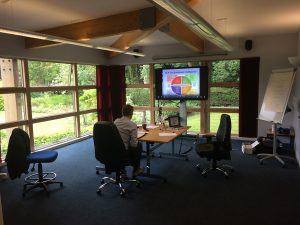
Stepping back
It can be good to step away and view things by letting the mind roll into new spaces, having a pleasant environment for that to happen.
Susan David suggests “successfully happy people are unstuck, they are agile.”
Agility is a physical state. The mind has a tendency to stuckness; nature has a tendency to become rotten, petrified, to gather dust and cobwebs; organisations and all structures have a tendency to dissipate and collapse over time; communication tends towards misunderstanding. By stepping away as at the session with my client, it was possible to consider how language can work creatively to oppose this – as a gardener manages a garden – and how various perceptual positions assist.
Seeing the wood for the trees

Seeing the whole
Where relationships are affected by so-called “negative somatic markers” we are aware of hot, warm and cold energy as time goes by from the initial disruption, and how the time and effort needed to “clean” the thoughts that become solidified out of the original emotions, multiply accordingly. Emotion turns to reasoned thought after time and creates the reality we perceive as normal.
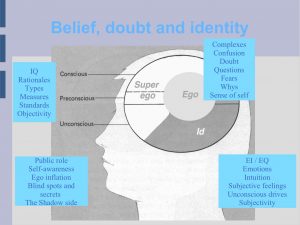
Hot, warm or cold?
In the coaching context, we connect the various channels for experience: what are the images when the client thinks of the problem and its outcomes for themselves, what are the words associated with these evoked images, what are the emotions they feel and where do they feel them?
The gap between envisioning something and the action itself and feeling the best way towards doing it … is filled by our voices, by our conversations with others and ourselves.
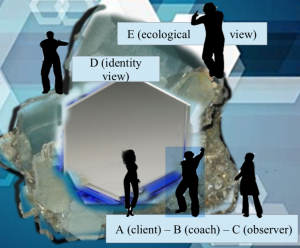
Co-active and more ….
So, the induction process of closing one’s eyes, listening, then thinking of a place and being in that, experiencing what is associated with that image, is about how to catalyse or uncover, from different levels, the rules or games of the activity that is under observation and the paradoxical language, incongruent behaviour and cognitive dissonance that are evoked along with it.

Conference comfort
In amongst the awareness of how language works internally and when used with others, and the elements of coaching that cover change psychology and theories – where the framing and reframing of experience, and the embedded presuppositions and beliefs of the other person are concerned, the co-active measures coaches employ as effective – we discussed how to cool off or park the emotions: by writing and re-reading our thoughts, later; by considering emotions as bodyguards; by realising that “the other is not me”; by understanding that taking more than 21 days to process the emotions leads to them becoming stuck; by remembering that when we sleep we cannot make mistakes, and that we cannot just “give” happy solutions, success, etc; then by considering our options for addressing the obstacle that may be felt to be preventing or blocking a good outcome, using various kinds of scaffold to reach those goals.
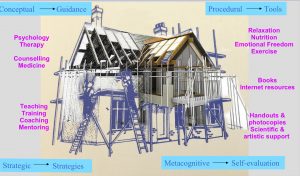
Layers of scaffolding
What state are you in?
Do you feel that everything is “normal” and steady – “business as usual”, or in a constant state of flux and uncertainty, giving you an uneasy even scary feeling in the pit of your stomach?

Coaching in York is in a great state!
After a great week at the International Coaching Week in York, during which so many interesting and important things were discussed, and meeting really great coaches, we left feeling inspired and full of ideas. I met or renewed contact with many great and inspiring coaches and language trainers, and we learnt how to be more agile in our work. How though can we help others to be agile?
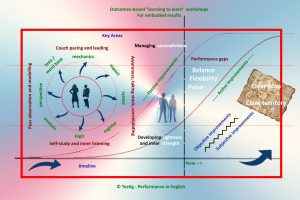
So many different states to be in!
There were many great themes – how to impact in people’s lives and work, helping them to reach their chosen goals; the in-company experience and culture; the importance of cultural understanding that is seen not as a block to communication but a means to greater discovery of our shared humanity; the immense width and depth of the coaching profession from the volunteer sector here in York and as far away as Sub-Saharan Africa, to how organisational coaching models and profiling techniques and questionnaires are so penetrating, helpful and enlightening; how also to harness the energy of the group or team; about the default working styles we tend to fall back into, and how to intervene even very briefly, in powerful ways, emphasising the importance of basing the conversation on verifiable facts. And these sessions were run in very different settings, in modern office suites, old historic buildings, in a field with horses, online, walking in gardens….
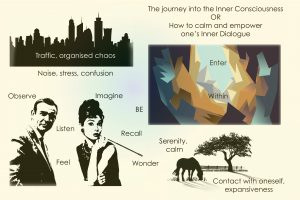
The state of our language
My main interest was how to link the insights of language acquisition science with the framing or contracting of goals or outcomes so that creative solutions may emerge and without adding to any implied sense of failure if the exact original targets or goals are not met. Having a “backwash of expectancy” (as this has been embedded in our thinking from childhood and with the added pressure of schooling and workplace expectations) is a fundamental stress of life, and the coach ought not to reinforce this; so, how to overcome the inevitable sense of destabilisation that impinges on the very coaching conversation itself whether we like it or not?
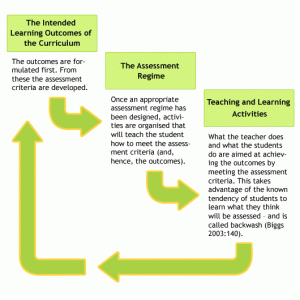
The state of the world
We know that new language is acquired by “taking ownership” of the words and phrases that we identify with, not merely by mimicking parrot-fashion or in the died-in-the-wool Pavlovian “rewards” or carrot-and-stick style. In the words “new language” I include the “new language” of our Inner Talk and self-talk that we find ourselves echoing – in the chamber of our heads – that results from the constant bombardments of the external world and the plethora of conflicting voices and messages, seemingly and confusingly ever-changing and at odds with one-another. As the conversation moved from psychology to culture to political science to art and music, so we entered new states.
The limitations of language
And one state we commented on is that when one has a different native language, the way the words are processed and “felt” is different, and so is the ability of the language itself to handle notions and experience – some things literally cannot be put into words in the same way or at all.
Our state of awareness
One thing I discussed with more than one person was the now ubiquitous assumption of the existence of “levels of skill” where performing tasks, whether as managers, teachers, sports people, in-company coaches working on goal-oriented matters, or counsellors or therapists helping unfortunates towards a better life, or indeed as coaches working towards a qualification, to become a coach!! And as we moved from place to place, building to building and room to room or person to person, so out awareness, and naturally, our states, changed..
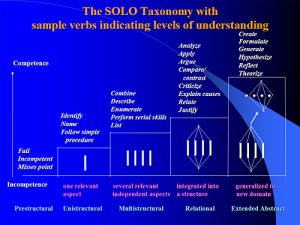
Stating the rules
Needless to say, it is in human nature in many ways to want to apply sets of rules – at the least, mutually-agreed ground rules or group cohesion rules – where a collective endeavour is concerned, and yet, when even we (as experienced coaches) were asked to abide by one-minute or 4-sentence-long self-imposed rules, or to move from table to table at a round-robin event every 15 minutes – and in one session, humorously, on pain of receiving a red card if we did not – we rarely abided by them completely, and conversations in groups could become slightly unevenly balanced and dare I say it, tending towards a more creative even chaotic sort!! This didn’t make them in any sense less enjoyable, in my opinion at least.
Destabilisation is an embodied state
Then I am someone who quite likes the idea of the occasional spanner in the works that throws “the expected” into disarray. Not everyone is the same in this regard, and the “destabilisation” felt by one as a curious intellectual problem dissociated from themselves, may be felt as another as threatening – as it does to me too of course at times. The so-called “frame games” (conscious or unconscious) that people experience (or play) can be equally confusing or disruptive, “are you addressing me as a coach, a mentor/master, follower/leader, or as a fellow human being here?”
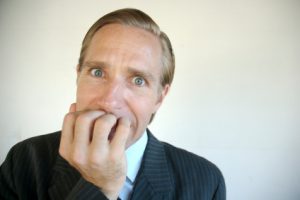
Commenting upon one’s state of mind or of body
Specific comments can be disruptive in this way; if a colleague inexplicably comments “is there something wrong, you don’t look you normal self today?” it can be taken as real concern or as a clever game; the brilliant 1920s books by Stephen Potter on “Gamesmanship” and “One-upmanship” perfectly encapsulated the deliberate attempt to broadside a rival or social inferior using a variety of funny ploys that nowadays seem unkind yet are still embedded in the psyche, in ways that Freud’s work on the neurotic shed so much light on.
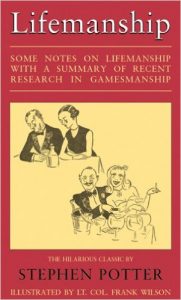
You know the words but do you know the music?
When we include reference to our embodied state, it can help to clarify the meaning of our words (and where those words come into our heads from). Since we can get in a “real state” due to people’s words and just as easily “tread on someone’s toes” and “put them out of kilter” inadvertently, I will hopefully be able to explain more in York’s coaching Circle, how I work with clients in embodied ways to overcome this.
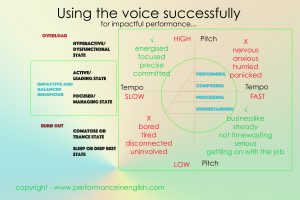
Pitch and Tempo and using the voice to impact performance.
Changes to where the coaching is carried out are important – taking clients away from their busy schedule and environment to peaceful and beautiful settings, walking in nature – role-playing similar but more impersonal scenarios with a more neutral position; stepping out of or away from the experience in real, physical as well as metaphorical ways; and working with the voice to show how the range of tonality, tempo and rhythm – working with the music of language, is truly the embodied link between what we can imagine and what we can actually do.

Dancing a dance comes from within: no amount of book-learning or talking about it, can take the place of the real feeling of movement. What we know about language acquisition reveals that prepping for a required outcome performance does not equate in any way to real acquisition – and this will be the same where shifting for changes in the coaching environment are concerned, or indeed any aspect of life.
What if it rains on the picnic?
If we organise a picnic, it’s not simply about deciding we want a picnic and then just having one. We first need to like the idea as well as find others who do, unpack the elements we and they choose and prefer, start to locate what else we need and think of where and when to do these things, before even attempting to actually go ahead. What if it rains on our picnic?
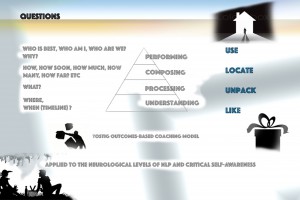
What’s the Objective – and subjective ?
Of equal importance arguably to getting the objective evaluations and validation of the outcomes-based goal – if it is in fact ever attained in quite the ways laid down by syllabuses and discourse models – is to get a subjective feeling of enjoyment and pleasure from everything we do, as in that way we do start to become masters of our own, entering the experience of life, whole and not disrupted, in tune with the reality we help to create.
In May 2018 I was proud to be involved in the York International Coaching week. 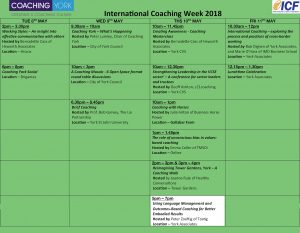 I spoke* at Peasholme House, the home of – and courtesy of Bob Dignen, Director of – York Associates. The ICW (full listings below**) is organised by Mr Peter Lumley, Chartered Fellow of the Chartered Institute of Personnel and Development (CIPD), and whose tireless work with Coaching York is putting this beautiful city well and truly on the map where coaching is concerned. *My workshop explored the importance of language mastery, and the cross-overs between language coaching and awareness, with topic/problem-based or situational-based coaching and mentoring, around personal and company goals and culture. It covered how more effectively to understand one’s physical response to a range of scenarios and thence embody purposeful and harmonious behaviour that is also conveyed in language. It thus focuses on how we understand and perform. There was also some analysis of personal and corporate “culture” as well as of the theory of chao-dynamics, looking at how outcomes emerge by dint of the mastery of language and the skilful ways in which communication is embodied. Please email me via info@tostig.co.uk There is a question in the back of my mind, preparing this, namely, what makes us want to listen and want to be involved; why do we sometimes “switch off” and why, at others, sit up in readiness? Embodied leadership states and how to access them, is a perennial aim for organisations wanting to avoid costly mistakes and get the best possible outcomes.
I spoke* at Peasholme House, the home of – and courtesy of Bob Dignen, Director of – York Associates. The ICW (full listings below**) is organised by Mr Peter Lumley, Chartered Fellow of the Chartered Institute of Personnel and Development (CIPD), and whose tireless work with Coaching York is putting this beautiful city well and truly on the map where coaching is concerned. *My workshop explored the importance of language mastery, and the cross-overs between language coaching and awareness, with topic/problem-based or situational-based coaching and mentoring, around personal and company goals and culture. It covered how more effectively to understand one’s physical response to a range of scenarios and thence embody purposeful and harmonious behaviour that is also conveyed in language. It thus focuses on how we understand and perform. There was also some analysis of personal and corporate “culture” as well as of the theory of chao-dynamics, looking at how outcomes emerge by dint of the mastery of language and the skilful ways in which communication is embodied. Please email me via info@tostig.co.uk There is a question in the back of my mind, preparing this, namely, what makes us want to listen and want to be involved; why do we sometimes “switch off” and why, at others, sit up in readiness? Embodied leadership states and how to access them, is a perennial aim for organisations wanting to avoid costly mistakes and get the best possible outcomes.

What would inspire me?
We confront the inevitable paradox: people are in positions who are in reality doing the opposite of what they are meant to do, or say that they are doing. The question arises, is this by mistake, by design, does it perhaps emerge from a sense of confusion? Is there even a perceived destabilisation culture, where we find ourselves having no other option, trapped, playing a role, wearing a mask that doesn’t fit too well?…. Consumer Strategic Insights (CSI) Director Jorge Rubio’s ‘Brain Spa’ was a kind of “creative space” designed to allow its participants to”set themselves free” of the numerous affective filters that prevent us from – as Jack Welsh was forever asking us to do – “reaching our full potential”, and removing barriers within the meritocracy.

How does this make you feel?
Language management, dealing with destabilisation in particular, is a way of delivering clear outcomes-based learning, incorporating a creative emergence of solutions at the same time. Outcomes-based notions are programmed into us from an early age; suffice it to say that the idea is pre-programmed into most children, as they grow up understanding that they need to learn (and often only learn) what is “in the test”. Cramming what I need to know “to get the answer right” is present in schooling and culture. It is there in the idea of the happy ending, of the end justifying the means, the ever-present teliological story format, the Tick-Tock that famously Professor Sir Frank Kermode referred to in his book, “The Sense of an Ending”. We live – according to this great critic – “In the Middest” and, this “Middle Time” – the age in which we now live – is characterised by a sense of permanent change, where what was “good” has declined and is in need of renovation. A process of painful purging needs to be undergone, which allows us to explain the chaos and ‘crisis’ we see unfolding around us. (Has some ancient trauma led to a state of amnesia in our deep collective unconscious perhaps re-emerging at troubling moments that we struggle to comprehend?)
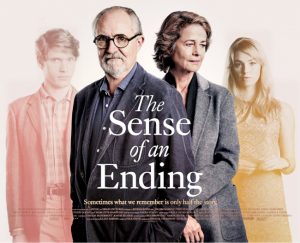
A recent film based around Julian Barnes’ reading of Professor Kermode’s theory
I read Kermode’s work when preparing my thesis in 1980 on Racine’s “Phèdre” and the idea that we already think we know the “ending” before it happens. Accordingly, in education, as in life and fiction, we feel the need to evaluate and be evaluated according to the “backwash” of expectancy, from the presupposed best or expected outcome – whether imposed by the parents, religion, traditions, the school system and its preparation for a career, or in work, the perceived company culture. Outcomes-based learning is a theory developed by John Biggs, using “constructive alignment”: we start with the outcomes we intend students to learn, and align teaching and assessment to those outcomes. Managerialism is explicitly eschewed within this theory, however.

How though, do we promote creativity, if participants believe there is a fixed outcome to be reached? As I shall outline in my talk, the way to bring about the emergence of creative solutions lies in how language is managed and in how we embody the process of change. Unfamiliar to many will be the work of Iyla Prigogine and Chaodynamics – that change is everywhere and in everything, that language is an attempt to make sense of natural state of flux, and culture is a way to fix and control or standardise the inevitable sense of destabilisation that comes from change. I have worked with this previously for many years and know it from political mechanisms of change as seen also in the works of Marcuse and Gramschi (I am not a proponent of these ideas) as well as in NLP.
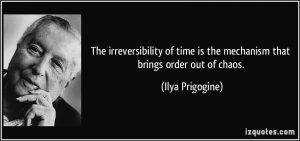
Viscount Ilya Romanovich Prigogine 25 January 1917 – 28 May 2003) a Belgian physical chemist and Nobel Laureate
As Frank Kermode also pointed out, what happens is irreversible because of the inevitability of the ticking clock of time, and that what is said cannot be unsaid; actions, when carried through, are complete. A view of human interaction is also developed from the work of Ilya Prigogine, noted for his work on dissipative structures, complex systems and irreversibility. 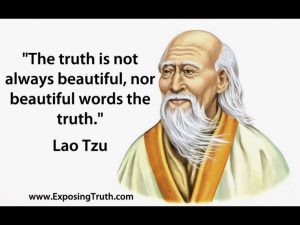
Managing one’s language implies a use of language to oppose the natural tendency to dissipation and destabilisation in complex systems, a kind of NLP for empowering – and to de-programme the mind and set it free. Prigogine developed the concept – at the University of Austin in Texas – of “dissipative structures” to describe the coherent space-time structures that form in open systems in which an exchange of matter and energy occurs between a system and its environment. This led to the theory of Chaodynamics and the idea of what he called a “concentric” approach to nature/communication to reestablish order after a major disruption. A good illustration of this can be found in theories of cultural change, and also, more negatively, as it is used in psychological warfare and in subversion tactics. In a demotivation stage, people worryingly and understandably feel bombarded with information and criticism, this leads to identity loss, and sometimes deliberately to the shaming of non-compliance. Acts or words that are violent or introduce sudden changes are used, silencing and censoring, and – in the most negative scenarios – setting up mechanisms of control through trusted accomplices and so-called useful idiots, or a sense of “us and them”. The coach’s work begins here to reverse this and re-establish truth and objectivity, establishing the principles of free speech and trust. Using language skilfully, the good leader or manager manages to bridge differences and overcome agitation from within, where the sense of disempowerment and imposition of a new narrative is often felt as being disenfranchising and as a real physical problem.

During a period of intense crisis, confused reactions and more identity confusion, loss of direction, even hysteria or blame are felt as a kind of internal warfare. The coach here listens and acts to encourage a clear and responsible use of words. By clarifying paradoxes, generalisations and unspecified references, deleted information, universals, or other presuppositions or patterns of language, that we note in NLP, we can bring about a creative outcome that is desired but not known or imposed from the outset. 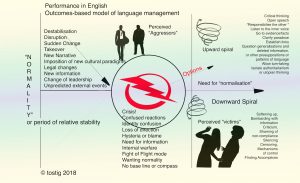
How, if a person is feeling intense demoralisation, can there be a change towards an empowered use of language that is at the same time elegant, powerful and poised? How do we bring gracefulness into an obviously stagnant sense of discomfort, or damaged stalemate?

In what might be considered a “normalisation” phase, the coach or other responsible actor – whatever their position – has a difficult task in liberating one who is at a stalemate or downward spiral, and challenging those who are perceived as aggressors, to reform their patterns of behaviour via critical thinking, open speech and by opposing authoritarianism or utopian thinking. So, looking at the “positive” side to this…. The coach works with perceptions in language with those perceived to have caused a de-stabilisation and and in order to establish facts in a neutral way and restore grace, poise and meaning to what is otherwise seen as desperate. This is then embodied in a physical way, turning defeat into victory and bringing about healthier, more mutually-beneficial outcomes.
** For the full listings and details please read here: ICW Events Listings2018 (1)
As Performance in English heads north to Yorkshire and to facilities being hired at the impressive Hawkhills conference centre, and close to the beautiful historic cities of York, Ripon, and the world-famous Spa town of Harrogate, our thoughts turn to food and the great culinary traditions – so little appreciated outside these small islands – of England.

Traditional foods…

A modern touch
It will surprise many that Yorkshire is proud to have been voted the best restaurant in the world, The Black Swan, in Oldstead, beating Heston Blumenthal’s The Fat Duck in Buckinghamshire and Raymond Blanc’s Le Manoir near Oxford.

Wonderful surroundings

Ox tongue
In fact, England currently has the top two restaurants worldwide; while Maison Lameloise, in Chagny, France, came in third, and L’Auberge de l’Ill, Illhaeusern, France was voted fourth and Martin Berasategui, Lasarte, Spain, fifth.

York Minster
The beautiful county of North Yorkshire has an amazing array of attractions and natural beauty, and – as a coaching client with us at The Hawkhills – you can also enjoy shopping in York or Harrogate, visits to places of tremendous interest, and the benefit of all sorts of entertainment.
From world-class World-famous theatre, to world-class shooting, and world-class tea rooms.…

World-famous

Anyone for tea?
…to world-class coaching…

Conference comfort
Don’t tell me what to do! – help me find it.
We sometimes feel we know what the other person means to say, or is trying to get across, and so advise them consciously or unconsciously towards solutions that we think work for us, and therefore would like to work for them. When we don’t understand, our first question is “why?” – but does this really help?

The author and coach, Nancy Kline, provides a good list of what not to do, when another person is speaking, which is quite useful in helping us eliminate bad habits. These include:
- Don’t finish the other people’s sentences.
- Don’t interrupt them in mid-sentence.
- Don’t look overly critical.
- Don’t fill in the pauses with your own stories and anecdotes.
- Don’t add information and ‘rules to follow’ during these listening phases.
- Don’t distract them by – perhaps unintentionally – looking at the clock, sighing, etc..

These seem like good general rules, but bad habits die hard! When helping someone to reach their goals, our own goal of “good helper” might take priority. Putting it more positively:
- Allow people to finish off their ideas
- Let them get to the end of their sentence
- Show interest in what they are bringing up
- During pauses, pay attention to the thinking process that you are observing
- While listening, develop rapport and collect important information
- Encourage speech and think of deep questions.
Questions
If we want to really know what the best solution is, and to help someone reach it, the more time spent knowing what they feel and how they see the world, the better. One does not climb a mountain without a map of the terrain. What if there is a smoother path, a quicker one, or a more picturesque one? How do I know what you prefer if I don’t take the trouble to ask? And how do I know what you are willing to change, unless you tell me?

I work regularly with managers and leaders who need to overcome difficulties of miscommunication – frequent where English is the lingua franca for business and negotiating. Finding ground for exploration working up from stable common perceptions is a very important skill, and one that, in the emotional heat of the moment, can be lost.
For this reason it is important to choose questions carefully and – often – to avoid the question “why?” until we have collected a lot more information first.
Where are we?
Where do we want to go?
How long do we have?
How long have we already spent?
Who are the best people to have involved?
What common ground do we have?
What makes the other person say what they do?
What are they not saying?
What is their aim?
What do they want to avoid?
What are they willing to consider changing?
What will they never change?
How can we proceed?
Being able to step back in one’s mind and having the firmly-anchored physical resources for doing so, are equally important (and very distinct). What may seem like a mountain to climb may be anything but.

“You can talk the talk but can you walk the walk?”

Introducing “embodied language skills“
As far back as we can trace, notions of proper conduct have been shaped by individuals, rather than by committees. Their starting point has been behaviour – often at mealtimes or during the public “stroll” – which has been seen as a reliable indication of how people are likely to behave elsewhere and of their character.
In a culture where civility, integrity and respect are given high status, the words that we use and the way we behave cannot be separated.

From the film “Kingsman”
When we speak, we also act. There is an inescapable link between our choice of words and their specific intent.
If it is cold in the room, we could say “It’s cold in here, can someone close the window please?”; or we could say; “Who left the window open?”; “Does anybody mind if I close the window?” even “It’s a bit chilly isn’t it, does anyone feel the same as me?” or “Why don’t you close that window for me?”
Whether we like it or not, how we are viewed by others is a combination of how we choose to dress, groom ourselves, eat, stand, walk, and move, and how we speak.
Some say “Manners maketh Man”.
In learning a language, well, and making strong positive impressions on others, this is not simply a matter of learning certain cultural “rules” or “customs” – thought these are certainly useful to know – but in identifying how we wish to fit into a situation and what our own values and sense of identity are.
The “embodied” skills that surround leadership and other powerful roles, come with a range of language registers and techniques.
We provide Personal Action Plans to bring to bear the latest tried and tested ideas of Neuroplasiticity, Integration training, Somatic coaching, Leonard Energy Training and the very important U-Theory, incorporating ‘the Blind spot of leadership’ and ‘Leading from the emerging future’.

“You never listen!”
How often a frustrated teenager might say that, and, in business too, how often people might be thinking this, but they do not say it – and barriers are building up, unseen?
How do we “get” people to listen?
Are we “really listening“?

A child might have listened a hundred times to the being told he/she should clean their teeth every night. But do they do it?
As the saying goes, it takes patience to listen but it takes real skill to pretend that you are. And while this is not something we recommend at all, many people are good at pretending! All the outward signals are there to convince the other person ……
In today’s busy world, where time is always pressurised, arguably there is a lack of true care for others in society. We “listen”, but is there any inner processing going on?
Plus, what works with talking to children doesn’t not necessarily work the same way when dealing with business associates etc.. If we are not listening, what alternative does that give to our colleagues?

Good listening matters at every level.
Everyone likes to think they know best, so, listening to what another person needs to say, attentively, is not just a real skill, it is also potentially a means for powerful change. How do we do it, when our own heads are so full of stuff we are desperate to get done, and get said?
It is important to remember that not everyone wants to be the one “up there” doing the spotlight work and receiving the credits. There is equal importance in what we do to help people achieve their own personal goals, wherever they work.
That goal might be to speak and understand English fluently and effectively, whether they are the Managing Director, in the back office, or at the front of house in a retail role. Having the right skills to really hear what is being said, can change the way an entire organisation works.
Actually, when there is good listening, all sides listen and benefit.

Stay in Touch
choose your language to view this site
tostig-PerformanceinEnglish company information
ZOEFTIG (TOSTIG)
Address:
West Paddock
Massey Lane
BB9 5JT
Pendle
Lancashire
t: +44 (0)7708364021
e: info@performanceinenglish.com
info@tostig.couk
D-U-N-S® number 21-693-0166
Companies House UK 7397654
Pages
- About Us
- Blog
- Calendar
- Change Management where English is the lingua franca
- Coaching Articles
- Elocution
- Exam preparation
- FAQ and contact form
- Home Page
- Intensive coaching the UK
- Job-oriented promotion coaching
- Listening skills
- Miscellaneous
- NLP/Hypnotherapy
- Other services and information
- Performance coaching with Embodied Leadership
- PIE for Actors
- Places of Interest
- Portfolio
- Privacy Policy
- Skype coaching
- Testimonials
- University academic pre-sessional
- VIP and high-status individuals
- Virtual Coaching and Training
- Voice and Leadership Coaching
- What is involved in Performance in English coaching?
Proud to be a long-standing Associate of..
Delighted to be collaborating with Learnlight, HR, L&D and Global Mobility leaders

Certificated GLA (Global Leadership Assessment 360˚) the world’s no.1 Leadership Coach

Freelance trainer with CERAN

We are proud to be associated with agents:

Associated with Coaching York
